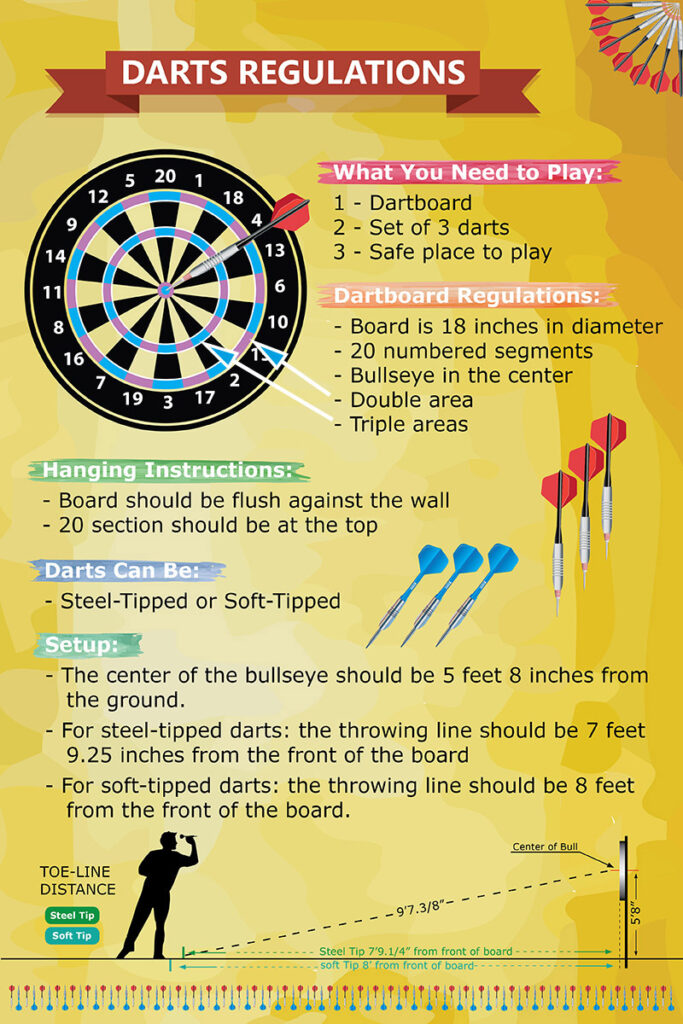Dart Board Regulations: Darts Rules for Height, Distance, & More
This page may contain affiliate links. If you make a purchase through one of our affiliate links, we'll earn a commission, at no extra cost to you.

Want to learn more about darts? On this page, you’ll find the dart board regulations and measurements you need to know. The graphic above also shows the most important data.
What You Need to Play the Game of Darts:
- A dartboard. It could be bristle (traditional), electronic, or magnetic.
- Set of 3 darts. It’s ideal to have a set of 3 darts for each player or team playing. The darts can be soft-tipped, steel-tipped, or magnetic. The type of darts you’ll need will depend on the type of dart board you’re using.
- A safe place to play. Make sure no one will be walking or standing too close the dart throwing area.
Please note, although we’ve listed magnetic darts and dartboards as options, there not recommended except for fun, usually with kids. For any type of competitive players, use either a bristle or electronic dartboard.
Also, ideally, you should have a tape measure and level to get the dart board at the correct height and to mark off the toe line for players.
Regulation Dartboard
The standard regulation dartboard is sometimes called a “clock” dartboard because of its resemblance to a clock, or it may be called a “London” dartboard. It has a bullseye (target) in the center, with an inner and outer bull.
Outside of the bullseye, it has 20 numbered segments that look like pie or pizza slices. Each numbered segment of the dartboard is of equal size. The numbered segments also have a thin outer ring that is the double area (this area is worth 2x the points). Towards the middle of each numbered segment is the narrow triple area (this area is worth 3x the points).
The regulation dartboard measures 18 inches in diameter. The 20 section should be at the top, and the board should be flush against the wall.
See our reviews and recommendations of the best dartboards, best darts, best dart flights, best dart cases, best electronic dart scoreboards, and best dartboard surrounds.
Dartboard Height
The regulation dart board should be hung so that the center of the bullseye is 5 feet 8 inches off the ground.
Regulation Throw Distance or Toe Line Distance (Steel Tip and Soft Tip)
Regulations of the dart throwing line, toe line, or oche (all names for the same thing) vary depending on whether you are playing with steel tip or soft tip darts.
It should be 7 feet 9.25 inches to the front of the dartboard if you are playing with steel tip darts. If you’re using soft tips darts, the toe line should be 8 feet from the front of the dartboard. You can mark the line with tape or chalk so the player knows where to stand. Tournaments often use a small block of wood that the player must stand behind. Alternatively, you can buy a dart throw toe line marker.
The toe line should have two feet of clearance on either side of the board so the standing darts player can stand slightly to the left or right to throw the darts if they prefer.
Hanging Instructions
The hanging or mounting process will vary depending on the dart board you’re using. Many, especially bristle dart boards, will have a triangle hook at the top so they can be easily hung using a nail. To get the correct height, measure from the center of the bullseye to the position of the hook where the nail will be. Add this distance to 5 feet 8 inches and you’ll have the correct height to place the nail.
Darts Rules
There are many different darts games and variations that you can play. I won’t cover them all here because the rules of the most popular games are covered in my comprehensive article, Darts 101. In that article, you’ll find how to play, the rules of the different games, and proper dart throwing techniques.
Embed This Image On Your Site (copy code below):
About the Author Alberto Restrepo
I live in Pennsylvania with my wife and four children. Time with family is very important to me, so I started Gameroom Vault to help others find fun ways to spend time with their families at home.
